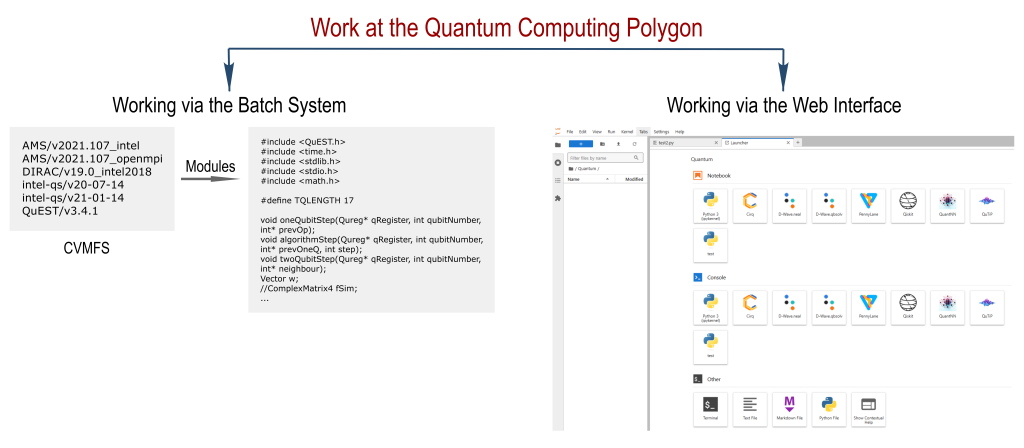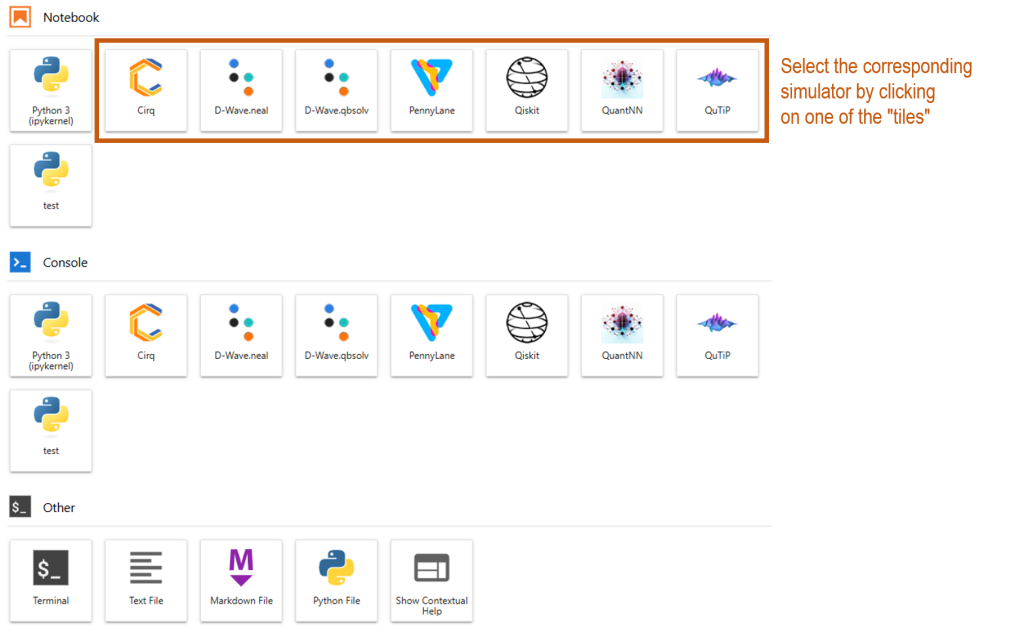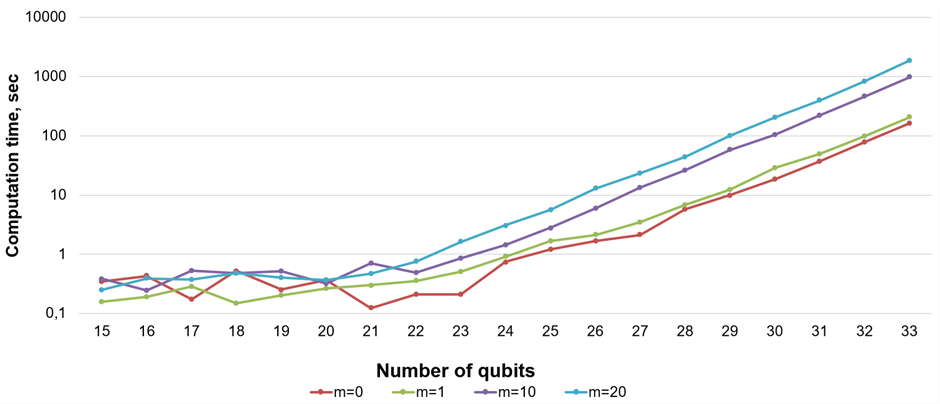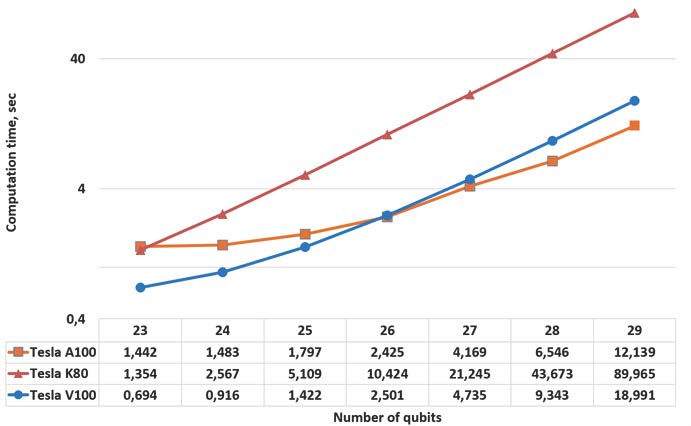- About the Quantum Computing Polygon
- Working on the Quantum Computing Polygon
- Test Task
- Example User Task
About the Quantum Computing Polygon
A Quantum Computing Polygonhas been deployed on the resources of the ML/DL/HPC ecosystem of the HybriLIT heterogeneous platform. The server’s specifications allow for computations using libraries that support parallel processing on both CPUs and GPUs.
Server specifications [https://ampere05.jinr.ru]:
- 2x AMD EPYC 7763 (64 Cores @ 2.45 GHz),
- 1.94 TB RAM,
- 8x NVIDIA Tesla A100 SXM4 80 GB HBM2
JupyterLab has been chosen as the core computing environment, providing users with a visual interface for working with quantum circuits and performing computations directly in a web browser.
Currently, the following quantum computing simulators are available on the testbed:
- Cirq — Examples: github.com/quantumlib/Cirq/
- Qiskit — Examples: github.com/Qiskit/
- PennyLane — Examples: pennylane.ai, github.com/MonitSharma
- QuTiP — Examples: qutip.org/qutip-tutorials, github.com/qutip
- DWave.neal — Examples: https://github.com/dwavesystems/dwave-neal
- DWave.qbsolv — Examples: https://github.com/dwavesystems/qbsolv
- QunatNN — A collection of libraries for working with quantum neural networks
Working at the Quantum Computing Polygon
Access to the server is provided only from within the internal JINR network.
To request access to the quantum computing polygon resources, please send an email with your user information (login) to: zuevmax@jinr.ru.
There are two available options for working on the quantum computing polygon:
- Working via the Batch System (Fig. 1, left).
Quantum simulators and all necessary libraries are installed on the CVMFS (CERN Virtual Machine File System). The Modules utility is used to load the required environment variables in the user’s session. Job execution is managed by the SLURM scheduler.
Advantages of this setup include:- The ability to perform multi-node calculations using MPI technology.
- Access to the full resources of the heterogeneous platform, including the “Govorun” supercomputer
To access the polygon via the batch system, please follow the instruction guide.
- Working via the Web Interface (Fig. 1, right).
Many modern quantum simulators are implemented in Python. To simplify working with them, a web-based extension of the quantum computing testbed has been developed, enabling users to run quantum simulations directly in a Jupyter environment.This setup provides users with a visual, browser-based interface for building and running quantum circuits. The polygon is deployed on a server capable of running computations on both CPUs and GPUs.
The web interface is based on JupyterLab, the multi-user version of Jupyter. Quantum simulators are available as separate modules. When a simulator is selected, a Jupyter Notebook is launched with the appropriate libraries and environment variables pre-configured.
Key benefits of using Jupyter Notebook:- Visual development of quantum algorithms,
- Intuitive circuit design and visualization,
- Access to a wide range of open-source Python materials, significantly speeding up research.

To access the quantum computing polygon via the web interface, follow these steps:
- Open a browser and go to ampere05.jinr.ru
- Log in using your HybriLIT platform username and password
- On the right side of the window, you will see “tiles” with the corresponding names of the available simulators (Fig.2):

Fig. 2. Choosing a quantum simulator - By selecting the corresponding tile and clicking on it with the left mouse button, a Jupyter Notebook will open, allowing you to work with the selected quantum simulator.
Test Task
For testing purposes, the QuEST quantum simulator was selected. It was used to evaluate performance on systems with both shared and distributed memory, as well as on graphics accelerators (GPUs) using CUDA technology.
The test results are presented in Figure 3 and Figure 4.
- Figure 3 shows a graph of the simulator’s runtime depending on the number of threads for different numbers of qubits. From the graph, it is evident that simulations of quantum systems with up to 33 qubits were achieved.

Fig. 3. Simulator’s runtime that depending on the number of threads for different numbers of qubits - Figure 4 displays the simulator’s runtime for various numbers of qubitson different graphics accelerators.

Fig. 4. Simulator’s runtime for various numbers of qubits different graphics accelerators
Example User Task
In this user task, the Cirq quantum simulator was used — a framework for quantum computing — to solve the problem of finding the ground state (lowest energy state) in the Ising model in a longitudinal magnetic field, using the Quantum Approximate Optimization Algorithm (QAOA).
A detailed description of the problem is provided in the paper: Yu. Palii, A. Bogolubskaya, D. Yanovich, Quantum approximation optimization algorithm for the Ising model in an external magnetic field [PDF], published in Physics of Particles and Nuclei, Vol. 55, No. 3, pp. 600–602. ISSN 1063-7796, 2024.
On one of the testbed servers equipped with two AMD EPYC 7763 processors (64 cores @ 2.45 GHz), the task was executed using 128 threads, resulting in a runtime of 3 hours and 20 minutes.
When run on a NVIDIA A100 GPU with the cuStateVec library, the runtime was reduced to 14.5 minutes.
The test run demonstrated the ability to simulate systems with up to 33 qubits.On this real-world task, a speedup of more than 200 times was achieved.

